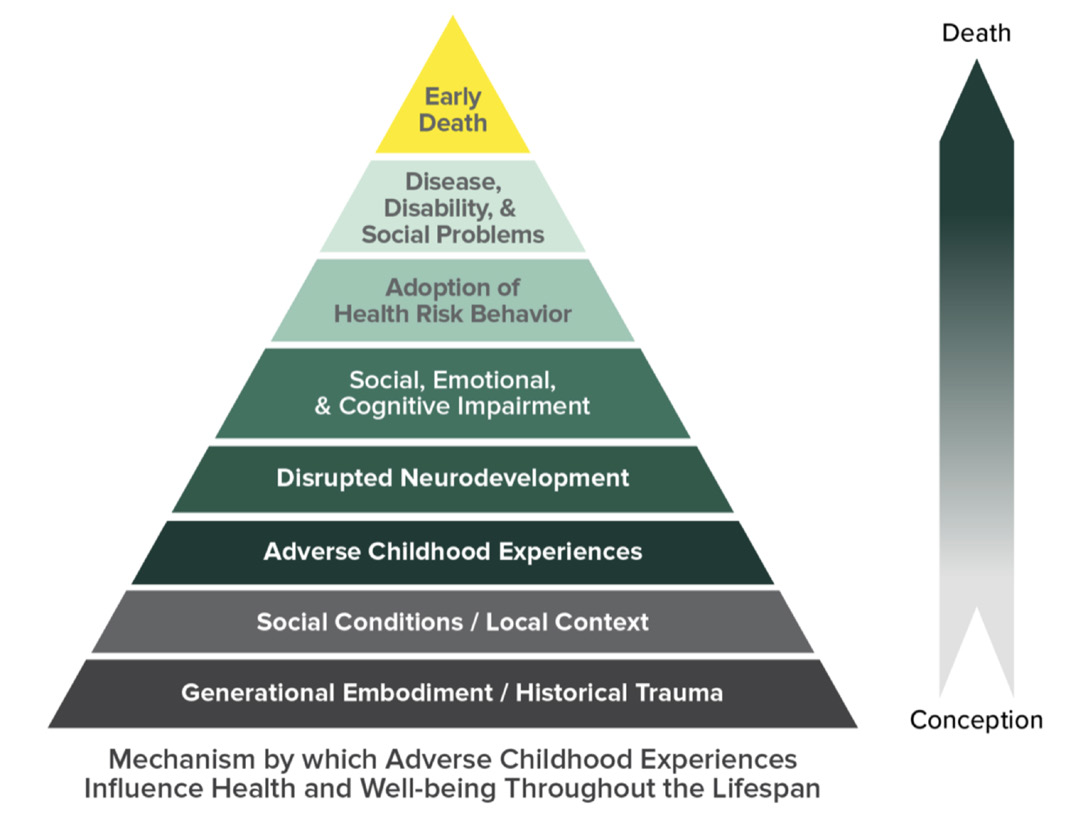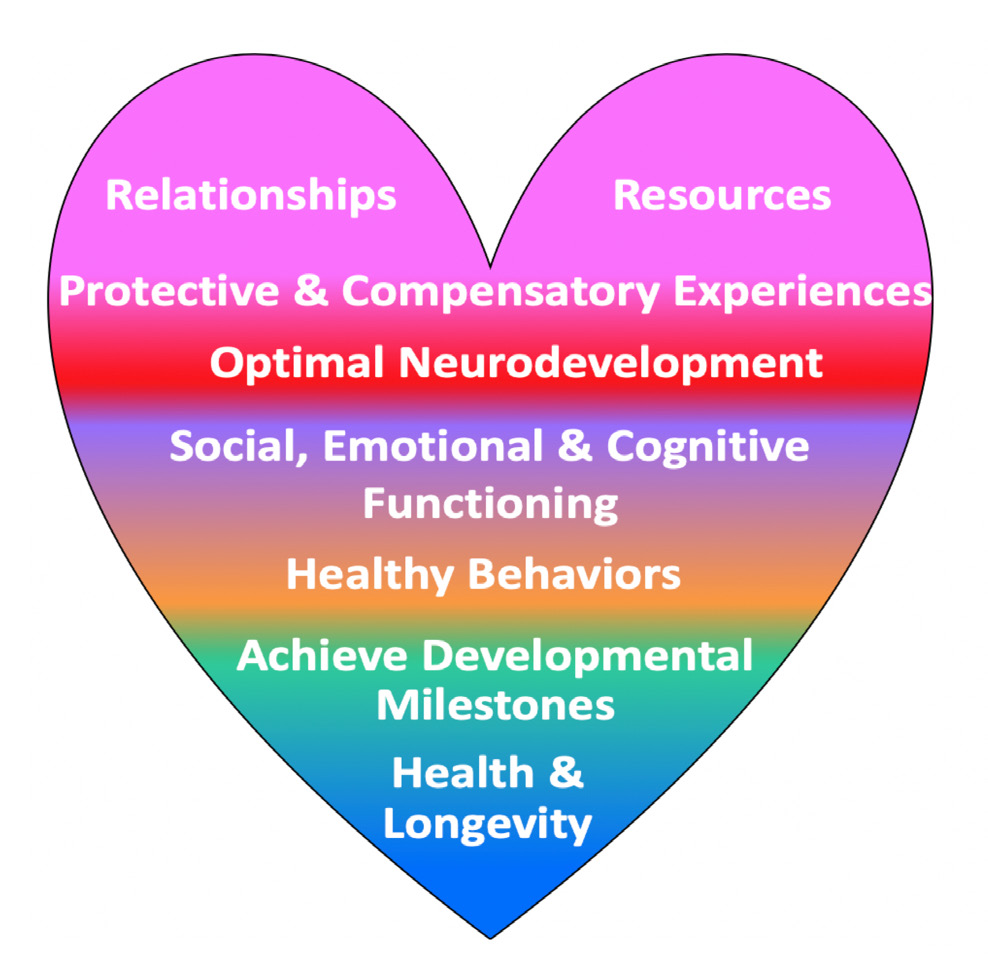The Impact of Adverse and Protective Childhood Experiences
What are Adverse Childhood Experiences (ACEs)?
Adverse Childhood Experiences (ACEs) include 10 categories of experiences before the age of 18: physical, sexual and emotional abuse; physical and emotional neglect; domestic violence; parental divorce; and household mental illness, incarceration and substance use. Having multiple ACEs impairs development and increases the risk of poor health.
The ACEs Study
In the 1990s, Drs. Vincent Felitti and Robert Anda examined ACEs in more than 17,000 adult patients.1 Patients’ ACE scores were then linked with their health records to assess the effects of ACEs on health.
Results of this research found that ACEs were:
- Common - two-thirds of the sample reported at least one ACE. More than one in five patients reported three or more ACEs.
- Co-occurring - experiencing one ACE increased the likelihood of having at least one other ACE.
- Cumulative - as ACEs increased, so did risk of physical and mental health problems.
Having four or more ACEs was related to a:
- Seven-fold increase in the risk of alcoholism1
- 4.5-fold increase in risk of illegal drug use1
- 6.6-fold increase in risk of early intercourse1
- 90% increase in risk of cancer2
- 60% increase in risk of diabetes2
- 2.2-fold increase in risk for heart disease2
- 2.4-fold increase in risk for stroke2
- 3.9-fold increase in risk for COPD2
- 4.6-fold increase in risk for depression2
- 12.1-fold increase in risk for suicide1
- 5.5-fold increase in committing intimate partner violence1
On average, individuals with six or more ACEs died nearly 20 years earlier compared to those with no ACEs.3
The findings from the original ACEs study have been repeated in populations across
the world. A 2018 study with more than 200,000 participants found the frequency of
ACEs remained stable in the last two decades. This study also found many groups with
an increased risk for ACEs. These groups include women, young adults, gay, lesbian
or bisexual
individuals and multiracial individuals.4
Effects of ACEs in Children and Teens
Research on children and teens shows that 20% to 48% have experienced more than one
ACE before the age of 18.5 Currently, Oklahoma is one of the states with the highest number of children with
ACEs per capita.6 ACEs have a cumulative impact on children’s well-being. Children with two
or more ACEs are:
- Three times more likely to repeat a grade7
- At a 10-fold increase in risk for having a learning or behavioral issue7
- Twice as likely to be overweight at age 97
Several child and teen populations are at an increased risk for ACEs. African American, American Indian and Hispanic children are more likely to experience ACEs than white or Asian children.8,9 Children in the child welfare system, the juvenile justice system and those living in poverty-stricken and/or violent neighborhoods are more likely to have a higher number of ACEs. Nearly 100% of teens in the juvenile justice system report at least one ACE and 90% report two or more.10
The ACEs Model
The ACEs model is a pyramid with ACEs as the base leading to changes in the brain,
which can result in impaired development.11 This can increase the likelihood of an individual engaging in poor coping behaviors
like smoking and overeating. These behaviors can increase risk for long-term health
problems. The ACEs model provides an understanding of how
ACEs impact health through the lifespan.
What are Protective and Compensatory Experiences (PACEs)?
Protective and Compensatory Experiences (or PACEs) are experiences that protect against risk and increase resilience.12 Like ACEs, PACEs influence development. Unlike ACEs, this foundation provides the relationships and resources needed for healthy development.
Ten relationship and resource PACEs include:
- unconditional love from a parent/caregiver
- having a best friend
- volunteering in the community
- being part of a social group
- having support from an adult outside of the family
- living in a clean, safe home with enough food
- having resources and opportunities to learn
- engaging in a hobby
- regular physical activity
- having daily routines and fair rules
PACEs have been related to greater mental well-being and higher income and education. PACEs also reduce harsh parenting attitudes among adults with high ACE scores.13
Caring for Children and Teens with ACEs
A child or teen that has experienced adverse events may engage in difficult behaviors stemming from fear or confusion. Caring for children and teens with ACES requires patience, consistency and warmth. There are ways for parents to lower stress and heal the effects of adversity.
- Parents can be emotion coaches. This involves providing supportive guidance to help children identify and regulate their emotions.13
- Parents should avoid the use of harsh discipline, which can be harmful.14
- Children and teens need a safe and supportive home environment with clear rules and limits.13
- Parents should try to create regular routines such as bedtime, play and family mealtime.14
- For teens, parents can encourage participation in activities, sports, clubs or volunteer groups.13
- Parents should maintain open communication with their teen, encouraging discussion and input.13
Caregivers with a History of ACEs
Parents and caregivers who have experienced ACEs can also benefit from the factors included in the PACE model.
- Forming healthy relationships with others can be healing for adults with ACEs.13
- Getting involved in community organizations, having and being a mentor and volunteering are ways to form new relationships.14
- Creating healthy habits, such as regular physical activity, healthy meals and enjoyable hobbies.14
- Professional counseling can be helpful in forming new coping behaviors and support healing from trauma.14
PACEs Heart Model
Protective experiences provide the basis for the PACEs heart model. Supportive relationships and resources lead to healthy development. Individuals then adopt behaviors resulting in healthy, long lives.
References
- Anda, R. F., Felitti, V. J., Bremner, J. D., Walker, J. D., Whitfield, C., Perry, B. D., . . . Giles, W. H. (2006). The enduring effects of abuse and related adverse experiences in childhood. A convergence of evidence from neurobiology and epidemiology. European Archives of Psychiatry and Clinical Neuroscience, 256(3), 174-186. doi:10.1007/s00406-005-0624-4
- Felitti, V. J., Anda, R. F., Nordenberg, D., Williamson, D. F., Spitz, A. M., Edwards, V., & Marks, J. S. (1998). Relationship of childhood abuse and household dysfunction to many of the leading causes of death in adults: The adverse childhood experiences (ace) study. American Journal of Preventive Medicine, 14(4), 245-258.
- Brown, D. W., Anda, R. F., Tiemeier, H., Felitti, V. J., Edwards, V. J., Croft, J. B., & Giles, W. H. (2009). Adverse childhood experiences and the risk of premature mortality. American Journal of Preventive Medicine, 37(5), 389-396.
- Merrick, M. T., Ford, D. C., Ports, K. A., & Guinn, A. S. (2018). Prevalence of adverse childhood experiences from the 2011-2014 Behavioral Risk Factor Surveillance System in 23 states. JAMA pediatrics, 172(11), 1038-1044.
- Saunders, B. E., & Adams, Z. W. (2014). Epidemiology of traumatic experiences in childhood. Child and Adolescent Psychiatric Clinics, 23(2), 167-184
- Bethell, C. D., Davis, M. B., Gombojav, N., Stumbo, S., & Powers, K. (2017). Issue Brief: A national and across state profile on adverse childhood experiences among children and possibilities to heal and thrive. Johns Hopkins Bloomberg School of Public Health, October 2017.
- Burke, N. J., Hellman, J. L., Scott, B. G., Weems, C. F., & Carrion, V. G. (2011). The impact of adverse childhood experiences on an urban pediatric population. Child Abuse & Neglect, 35(6), 408-413. doi:10.1016/j.chiabu.2011.02.006
- Sacks, V., & Murphey, D. (2018). The prevalence of adverse childhood experiences, nationally, by state, and by race or ethnicity.
- Kenney, M. K., & Singh, G. K. (2016). Adverse childhood experiences among American Indian/Alaska native children: the 2011-2012 national survey of children’s health. Scientifica, 2016.
- Baglivio, M. T., Epps, N., Swartz, K., Huq, M. S., Sheer, A., & Hardt, N. S. (2014). The prevalence of adverse childhood experiences (ace) in the lives of juvenile offenders. Journal of Juvenile Justice, 3(2).
- CDC. (2018). Adverse childhood experiences presentation graphics. Retrieved from https://www.cdc.gov/violenceprevention/acestudy/ACE_graphics.html
- Morris, A. S., Hays-Grudo, J., Treat, A. E., Williamson, A.C., Huffer, A., Roblyer,
M. Z., & Staton, J. (2015). Assessing resilience using the protective and compensatory
experiences survey (paces). Paper presented at the
Society for Research in Child Development, Philadelphia, Pennsylvania - Hays-Grudo, J. & Morris, A.S. (in press). Adverse and protective childhood experiences: A developmental perspective. Washington DC: APA Press.
- ACEs Connection (2018) Communities. https://www.acesconnection.com


